

© Shipping Wonders of the World 2012-

Important Foreign Navies
Germany, since the agreement of June 1935 with Great Britain, is fast building an efficient modern fleet. The USSR is credited with an ambitious programme of naval construction. In addition, there are thirty-six smaller naval forces of varying strength
FLEETS OF THE FOREIGN POWERS - 5
This chapter briefly describes the following navies:
Holland (including the Dutch East Indies)
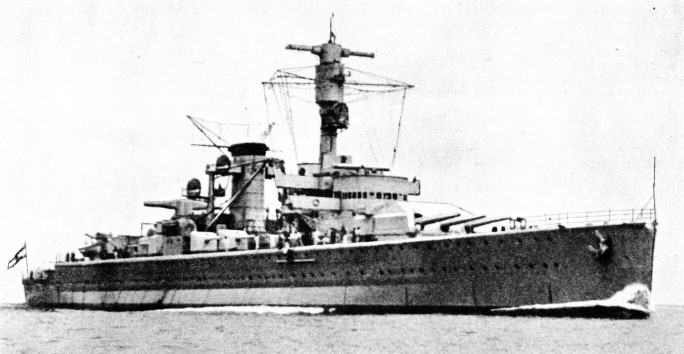
THE “POCKET BATTLESHIP” laid down for the German Navy in 1929 completely revolutionized foreign ideas of construction. Of a displacement limited by treaty to 10,000 tons, the Deutschland is armed with six 11-
GERMANY, since the agreement of June 1935 with Great Britain, is fast building an efficient modern fleet. The U.S.S.R. is credited with an ambitious programme of naval construction In addition, there are thirty-
Germany is now free to develop her sea power on a scale commensurate with her regained status as a Sovereign Power, the size of her fleet being restricted only by the naval agreement with Great Britain into which Germany voluntarily entered in June 1935. Under this compact, it was agreed that German naval tonnage should at no time exceed 35 per cent of the British total, with the proviso that a somewhat higher ratio of submarine strength should be permissible and that, in principle, Germany should have the right to build up to submarine equality with Great Britain.
The Treaty of Versailles enacted that Germany should build no armoured ships above 10,000 tons, no cruisers above 6,000 tons, and no destroyers exceeding 800 tons. She was further debarred altogether from building or acquiring submarines of any description. These conditions were faithfully observed for a period of about fifteen years, during the greater part of which the German fleet remained in a condition of almost complete impotence. Eventually a few cruisers and destroyers were built in conformity with Treaty restrictions, but it was not until 1929 that Germany sprang her remarkable technical surprise.
In that year was laid down the first unit of what became known as the “pocket battleships”. There is little doubt that these ships were designed less from purely naval motives than with the intention of showing the world that German genius could rise superior to the artificial fetters imposed on her naval architects.
Although the Deutschland, as this first vessel was named, had a displacement tonnage of only 10,000 and was therefore no larger than the British “County” class cruisers, she was in effect a miniature battle cruiser. As compared with the cruisers’ armament of eight 8-
In this ship and her sisters, Admiral Scheer and Admiral Graf Spee, welding was largely employed during construction, and many other methods of saving weight were adopted. In view of the close secrecy observed by the German naval authorities there is little reliable information concerning the behaviour of these pocket battleships in service. There is, however, reason to believe that when the diesel engines are running at certain speeds a good deal of vibration and noise is set up, and the system of fire control for the guns seriously affected. The building of these ships, however, reflects great credit on the German shipbuilding and engineering professions. Even after having discounted the possibly exaggerated claims made on their behalf, it remains a fact that the Deutschland and her sisters have introduced a new element into naval strategy because of their exceptional cruising endurance, relatively high speed and powerful armament. It is certainly not entirely a coincidence that since their advent the building of 10,000-
As soon as that happened, a fourth Deutschland already on order was cancelled, and in its place two full-
The process of creating a powerful battle fleet is already in full swing, and in the course of the next few years the German Navy will inevitably advance from secondary to first rank. Steady progress is being made with the building of cruisers, six of which have been launched since 1925. With the exception of the Emden, they are vessels of 6,000 tons, with a speed of 32 knots and a main armament of nine 5.9-
Four 10,000-
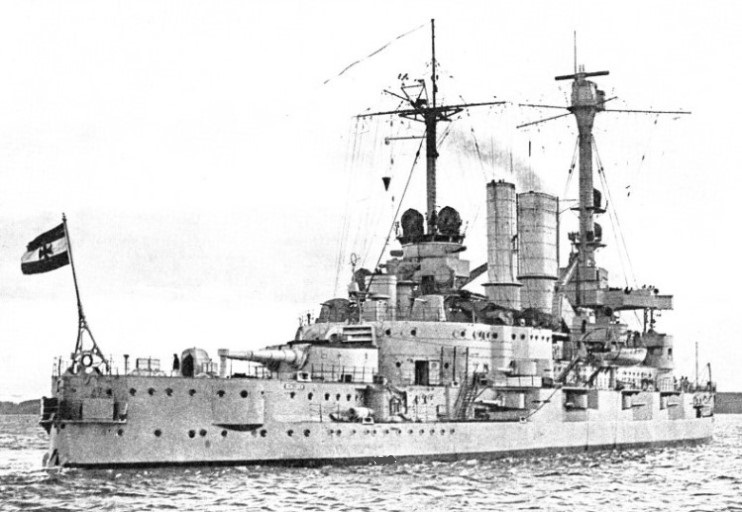
NOW A CADET TRAINING SHIP, the Schlesien is a German battleship built in 1906. She has a displacement of 13,040 tons, a length of 413 feet, a beam of 72 ft. 10 in. and a mean draught of 25 ft. 3 in. She was rebuilt in 1926-
Germany in 1935 resumed the building of submarines, and in that year laid down no fewer than twenty-
These diminutive craft are believed to have been built mainly for training purposes, though they are capable of remaining at sea for considerable periods and have a definite degree of fighting value. From a number of the boats the electric motors and storage batteries have been removed, and when under water they are now propelled by the internal combustion engine working on a mixture of hydrogen and oxygen, a supply of this gaseous fuel being carried in steel flasks. The system is said to be capable of application to large submarines, which would manufacture their own gas by means of a high-
Eight more submarines were begun in 1936, to bring the German strength up to three complete flotillas of twelve boats each. The submarine school at Kiel, which had been closed since the Armistice in 1918, was reopened in 1935, and there are reported to be more than 1,000 officers and men under training there.
Although conscription has lately been reintroduced, the backbone of the naval personnel consists of volunteers who have enlisted for twelve years’ service, and are therefore highly trained men. At the present time, it is estimated, 20,000 of these long-
The training is extremely thorough, and includes several months spent on board a sailing ship. Officers are entered between the age of 17½ and 18, and, after having passed through the naval academy at Mürwik, near Kiel, they make a voyage round the world in a cruiser. As in the British Navy, young officers are encouraged to specialize in navigation, gunnery, torpedo work or signalling. The engineering branch is kept distinct from the executive, though the wide social gulf that divided these two branches in the old German Navy no longer exists.
Gunnery practice figures prominently in the training programme. Following the example of the British Navy, an old battleship, the Zahringen, has been fitted out as a wireless-
The torpedo has always been a popular arm in the German service, and now that so many new destroyers and submarines are coming into service, torpedo tactics are being developed on a major scale. Among the new types now in production is a torpedo propelled by electricity, which, in contrast to the compressed-
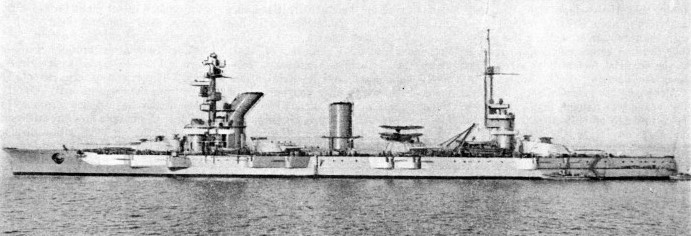
A SOVIET BATTLESHIP OF 23,606 TONS DISPLACEMENT, the Marat was completed in 1914 as the Petropavlovsk. She has an overall length of 619 feet, a beam of 87 feet and a mean draught of 27 ft. 6 in. Her bows are capable of being used for ice-
BECAUSE of the reticence observed by Moscow, the strength and composition of the Russian Navy remain somewhat obscure, but there is evidence of considerable progress in every branch of the service.
Three old battleships dating from 1914-
The bulk of the Russian Navy is in the Baltic, but a squadron is maintained in the Black Sea and, within recent years, the naval force in the Far East has been substantially augmented, chiefly by submarines sent in sections over the Trans-
Russia remains something of a “dark horse” among the naval Powers.
In addition to what may be called the “Big Seven” who head the hierarchy of naval Powers, there are no fewer than thirty-
The Spanish Navy, which in the civil war of 1936 came into prominence, contains a number of ships which will bear comparison with any afloat. It includes two small battleships of the dreadnought type, two 10,000-
Among the smaller navies in Europe that of Sweden cuts perhaps the most impressive figure. Its ships, though small, are of excellent design. For their size the three miniature battleships of the Sverige class are probably the most powerful afloat. Displacing 7,000 tons, they mount an armament of four 11-
A particularly interesting ship is the aircraft cruiser Gotland, completed in 1935. She displaces 4,600 tons, has a speed of 27 knots, and mounts six 6-
Holland is a great Colonial Power, and for this reason the greater part of its naval forces permanently serves overseas. With rare exceptions new ships, as soon as completed, are detailed to the East Indies squadron based on Java, the only vessels retained in home waters being minelayers and a few torpedo-
The Dutch East Indies squadron is not powerful enough to defend the extensive and valuable Eastern territories, such as Java, Sumatra and Borneo, under the Dutch flag against attack by a first-
There are no capital ships proper in the Netherlands fleet, the only armoured vessels being three coast defence ships averaging 5,000 tons and armed with 11-
An interesting vessel still under construction in 1936 was the flotilla leader Tromp, embodying an entirely new design. Displacing 3,350 tons she has a contract speed of 32½ knots, and is armed with six 5.9-
The submarine flotilla is exceptionally powerful, comprising as it does twenty-
Since the refortification of the Dardanelles, Turkey has once more become what the Germans call a “power factor” in European strategy. She already has the nucleus of what may become a
respectable fleet, though shortage of money is holding up the ambitious programme of construction which was approved in principle a few years ago. The largest warship under the Ottoman flag is the Yavuz, formerly the German battle cruiser Goeben which helped to make history in 1914-
Turkey has also two old cruisers, four big destroyers of the latest design, and five submarines, in addition to a miscellaneous collection of gunboats, minelayers and the like. It is understood that certain foreign officers are serving in the Turkish Navy as instructors.
Yet another of the smaller European navies deserving of mention is that of Finland, if only because of the unusual character of its material. It contains two vessels which not inaptly can be described as “vest-
Besides half a dozen patrol gunboats and a number of minelayers, Finland owns five submarines, one of which, the Saukko, has the distinction of being the tiniest undersea craft in the world. Her displacement is only 99 tons, yet she has a cruising radius of nearly 400 miles and carries a small gun, two torpedo tubes and nine mines.
Each of the three leading South American navies constitutes a fairly well-
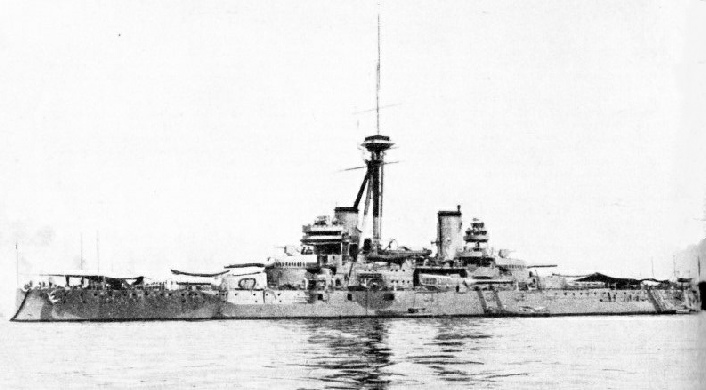
BEFORE HER ALTERATIONS IN 1936, the Brazilian battleship Minas Geraes had two funnels, which have since been replaced by one funnel abaft the mast. Of 19,200 tons displacement, the Minas Geraes was built in 1908 on the River Tyne. She has a length of 533 feet on the water-
The chief units of the Brazilian fleet are two British-
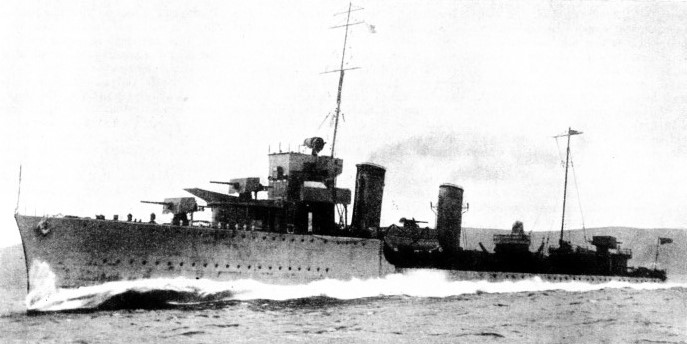
A SPEED OF 35 KNOTS was exceeded on the trials of the Chilean destroyer Orella, laid down with her five sisters in 1927. With a displacement of 1,090 tons, the Orella has an overall length of 300 feet, a beam of 29 feet and a draught of 12 ft. 8 in. Her geared turbines have a designed horse-
No South American State has finer naval traditions than Chile. Her present fleet is small, but it contains some modern units and is considered by foreign observers to be extremely efficient. Its largest vessel is the battleship Almirante Latorre, which served during 1914-
This review of the world’s smaller fighting fleets shows that nearly every State with pretentions to sovereignty finds it worth while to maintain a naval establishment which must in the majority of instances impose a heavy burden on the national exchequer. It is possible that the abolition of any one of these miniature navies would lead to a local outbreak of piracy, or at least to a marked increase in smuggling and other lawless activities.
You can read more on “The Ciudad de Buenos Aires”, “Dutch Shipping” and “German Shipping” on this website.